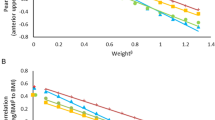Abstract
For comparative purposes, normalisation of strength measures to body size using allometric scaling is recommended. A wide range of scaling exponents have been suggested, typically utilising body mass, although a comprehensive evaluation of different body size variables has not been documented. Differences between force (F) and torque (T) measurements of strength, and the velocity of measurement might also explain some of the variability in the scaling exponents proposed. Knee extensor strength of 86 young men was assessed with measurement of torque at four velocities (0–4.19 rad s−1) and force measured isometrically. Body size variables included body mass, height and fat-free mass. Scaling exponents for torque were consistently higher than for force, but the velocity of torque measurement had no influence. As the confounding effects of fat mass were restricted, scaling exponents and the strength of the power-function relationships progressively increased. Fat-free mass determined a surprisingly high proportion of the variance in measured strength (F, 31%; T, 52–58%). Absolute force and torque measurements, and even torque normalised for body mass, were significantly influenced by height, although strength measures normalised to fat-free mass were not. To normalise strength measurements to body mass, for relatively homogenous lean populations (body fat <20%), exponents of 0.66 (F) and 1.0 (T) are appropriate. For more adipose populations (body fat >20%) lower body mass exponents appear more suitable (F, 0.45; T, 0.68). Nevertheless, fat-free mass is the recommended index for scaling strength to body size, and higher exponents (F, 0.76; T, 1.12) are advocated in this case.
Similar content being viewed by others
References
Astrand PO, Rodahl K (1986) Textbook of work physiology. 3rd edn. McGraw-Hill, New York, pp 391–410
Bunout D, Barrera G, De La Maza T, Avendano M, Gattas V, Petermann M, Hirsch S (2004) Lean and fat mass as determinants of muscle strength and insulin sensitivity in Chilean elderly subjects. J Nutr Health Aging 8:374–378
Davies MJ, Dalsky GP (1997) Normalizing strength for body size differences in older adults. Med Sci Sports Exerc 29:713–717
Durnin JVGA, Womersley J (1974) Body fat assessed from total body density and its estimation from skinfold thickness: measurements on 481 men and women aged from 16 to 72 years. Br J Sports Med 32:77
Folland JP, Hawker K, Leach B, Little T, Jones DA (2005) Strength training: Isometric training at a range of joint angles versus dynamic training. J Sports Sci 23:817–824
Folland JP, Leach B, Little T, Hawker K, Myerson S, Montgomery H, Jones D (2000) Angiotensin converting enzyme genotype affects the response of skeletal muscle to functional overload. Exp Physiol 85:575–579
Hawes MR, Martin AD (2001) Human body composition. In: Eston R, Reilly T (eds) Kinanthropometry and exercise physiology laboratory manual volume 1: anthropometry. Routledge, London, pp 7–43
Holmback AM, Porter MM, Downham D, Andersen JL, Lexell J (2003) Structure and function of the ankle dorsiflexor muscles in young and moderately active men and women. J Appl Physiol 95:2416–2424
Hulens M, Vansant G, Lysens R, Claessens AL, Muls E, Brumagne S (2001) Study of differences in peripheral muscle strength of lean versus obese women: an allometric approach. Int J Obese 25:676–681
Jaric S (2002) Muscle strength testing: use of normalisation for body size. Sports Med 32:615–631
Jaric S (2003) Role of body size in the relation between muscle strength and movement performance. Exerc Sport Sci Rev 31:8–12
Jaric S, Radosavljevic-Jaric S, Johansson H (2002a) Muscle force and torque in humans require different methods when adjusting for differences in body size. Eur J Appl Physiol 87:304–307
Jaric S, Ugarkovic D, Kukoli M (2002b) Evaluation of methods for normalising muscle strength in elite and young athletes. J Sports Med Phys Fitness 42:141–151
Jones DA, Parker DF (1989) Development of a portable strain gauge to measure human muscle isometric strength. J Physiol 145:11P
Kanehisa H, Ikegawa S, Fukunaga T (1994) Comparison of muscle cross-sectional area and strength between untrained women and men. Eur J Appl Physiol 68:148–154
Maughan RJ, Watson JS, Weir J (1983) Strength and cross-sectional area of human skeletal muscle. J Physiol 338:37–49
Nevill AM, Ramsbottom R, Williams C (1992) Scaling physiological measurements for individuals of different body size. Eur J Appl Physiol 63:110–117
Nevill AM, Holder RL, Baxter-Jones A., Round JM, Jones DA (1998) Modelling developmental changes in strength and aerobic power in children. J Appl Physiol 84:963–970
Parker DF, Round JM, Sacco P, Jones DA (1990) A cross-sectional survey of upper and lower limb strength in boys and girls during childhood and adolescence. Ann Hum Biol 17:199–211
Siri WE (1956) The gross composition of the body. Adv Biol Med Phys 4:239–80
Sholl D (1948) The quantitative investigation on the vertebrate brain and the applicability of allometric formula to its study. Proc Roy Soc B 135:243–258
Vanderburgh PM, Mahar MT, Chou CH (1995) Allometric scaling of grip strength by body mass in college-age men and women. Res Q Exerc Sport 66:80–84
Weir JP, Housh TJ, Johnson GO, Housh DJ, Ebersole KT (1999) Allometric scaling of isokinetic peak torque: the Nebraska Wrestling study. Eur J Appl Physiol 80:240–248
Author information
Authors and Affiliations
Corresponding author
Rights and permissions
About this article
Cite this article
Folland, J.P., Mc Cauley, T.M. & Williams, A.G. Allometric scaling of strength measurements to body size. Eur J Appl Physiol 102, 739–745 (2008). https://doi.org/10.1007/s00421-007-0654-x
Accepted:
Published:
Issue Date:
DOI: https://doi.org/10.1007/s00421-007-0654-x



